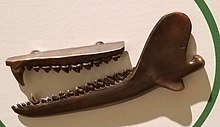| Docodon Temporal range: Upper Jurassic PreꞒ Ꞓ O S D C P T J K Pg N | |
|---|---|

| |
| Bronze model of upper and lower jaws | |
| Scientific classification | |
| Domain: | Eukaryota |
| Kingdom: | Animalia |
| Phylum: | Chordata |
| Clade: | Synapsida |
| Clade: | Therapsida |
| Clade: | Cynodontia |
| Clade: | Mammaliaformes |
| Order: | †Docodonta |
| Family: | †Docodontidae |
| Genus: | †Docodon Marsh, 1881 |
| Species | |
*probable synonyms | |
Docodon (meaning 'beam tooth') is an extinct docodont mammaliaform from the Late Jurassic of western North America. It was the first docodont to be named.
Description

Docodon was the first docodontan cynodont found and named, and later gave its name to the family Docodontidae as well as the order Docodonta. Docodonts had more complex shaped teeth than other early non-mammalian mammaliaforms, with piercing and crushing surfaces that would have allowed members of this family to eat a wider range of food types. These complex teeth are more similar to those of later mammal groups, but evolved independently of them.
Unlike many of its coexisting mammal relatives from the Mesozoic, Docodon is known from a large number of teeth and jaws of differing growth stages. This has made it possible to study the growth of this docodontan, and has revealed how docodont jaws change from juvenile stages to adulthood.
Discovery
Docodon was discovered by William Harlow Reed and named by Othniel Charles Marsh in 1880. Like many other early small mammaliaforms, it is known mainly from fossilized teeth and jaws, as these are the hardest parts of the body and survive more easily in the fossil record. Docodon fossils are found most commonly in the Black Hills region of South Dakota.
Its height is estimated at 10 centimeters with an approximate weight of 30 grams, making it one of the larger mammaliaforms known from the Morrison Formation.
Species
A number of species have been erected, but most are now considered to represent D. victor, with differences being attributed to differing ages of the individuals represented. However, D. apoxys is still considered a separate species from D. victor due to differing numbers of tooth roots.
- Docodon victor
- Docodon apoxys
- Docodon hercynicus
See also
References
- ^ Marsh, O. C. (1880). "Notice on Jurassic mammals representing two new orders". American Journal of Science. 20 :235-239.
- ^ Rougier, G. W.; Sheth, A. S.; Carpenter, K.; Appella-Guiscafre, L. & Davis, B. M. (2014). "A new species of Docodon (Mammaliaformes: Docodonta) from the Upper Jurassic Morrison Formation and a reassessment of selected craniodental characters in basal mammaliaforms". Journal of Mammalian Evolution. 22: 1-16.
- ^ Martin, T.; Averianov, A. O.; Lang, A. J.; Schultz, J. A.; Wings, O. (2024). "Docodontans (Mammaliaformes) from the Late Jurassic of Germany". Historical Biology: 1–9. doi:10.1080/08912963.2023.2300635. S2CID 267167016.
- Kretzoi, M. (1946). "On Docodonta, a new order of Jurassic Mammals". Anneles Historico-Naturales Musei Nationalis Hungarici. 39 :108-111.
- ^ Schultz, J. A.; Bhullar, B.-A. S. & Luo, Z.-X. (2018). "Re-examination of the Jurassic mammaliaform Docodon victor by computed tomography and occlusal functional analysis". Journal of Mammalian Evolution. in press. doi:10.1007/s10914-017-9418-5
- Foster, J. R.; Trujillo, K. C.; Madsen, S. K. & Martin, J. E. (2006). "The Late Jurassic mammal Docodon, from the Morrison Formation of the Black Hills, Wyoming: implications for abundance and biogeography of the genus". New Mexico Museum of Natural History and Science Bulletin. 36: 165–169.
- Chure, D. J.; Litwin, R.; Hasiotis, S. T.; Evanoff, E. & Carpenter, K. (2006). "The fauna and flora of the Morrison Formation". In Palaeontology and Geology of the Upper Jurassic Morrison Formation. Foster, J. R & Lucas, S. G. R. M. (eds). New Mexico Museum of Natural History and Science Bulletin 36.
External links
| Taxon identifiers | |
|---|---|
| Docodon | |





